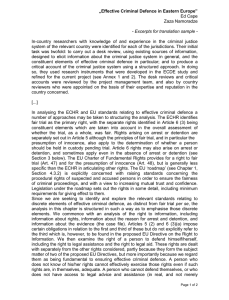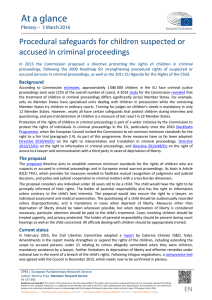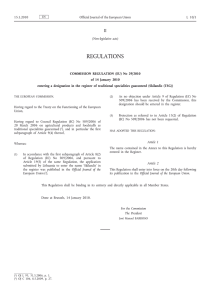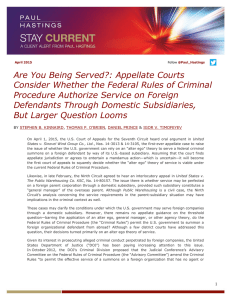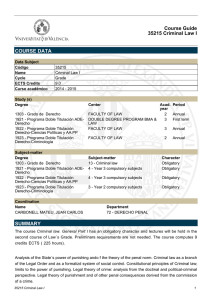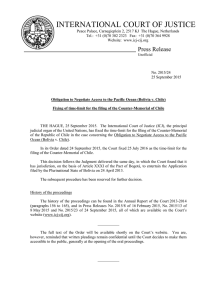Exchange of Information on Third Country Nationals
Anuncio
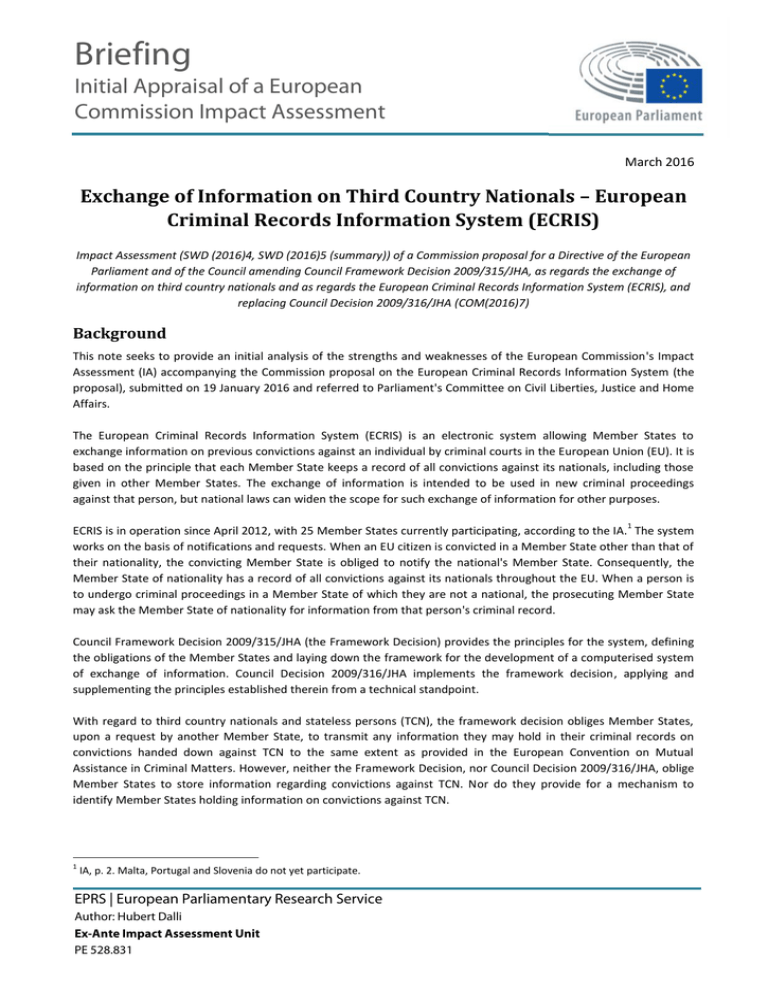
Briefing Initial Appraisal of a European Commission Impact Assessment March 2016 Exchange of Information on Third Country Nationals – European Criminal Records Information System (ECRIS) Impact Assessment (SWD (2016)4, SWD (2016)5 (summary)) of a Commission proposal for a Directive of the European Parliament and of the Council amending Council Framework Decision 2009/315/JHA, as regards the exchange of information on third country nationals and as regards the European Criminal Records Information System (ECRIS), and replacing Council Decision 2009/316/JHA (COM(2016)7) Background This note seeks to provide an initial analysis of the strengths and weaknesses of the European Commission's Impact Assessment (IA) accompanying the Commission proposal on the European Criminal Records Information System (the proposal), submitted on 19 January 2016 and referred to Parliament's Committee on Civil Liberties, Justice and Home Affairs. The European Criminal Records Information System (ECRIS) is an electronic system allowing Member States to exchange information on previous convictions against an individual by criminal courts in the European Union (EU). It is based on the principle that each Member State keeps a record of all convictions against its nationals, including those given in other Member States. The exchange of information is intended to be used in new criminal proceedings against that person, but national laws can widen the scope for such exchange of information for other purposes. 1 ECRIS is in operation since April 2012, with 25 Member States currently participating, according to the IA. The system works on the basis of notifications and requests. When an EU citizen is convicted in a Member State other than that of their nationality, the convicting Member State is obliged to notify the national's Member State. Consequently, the Member State of nationality has a record of all convictions against its nationals throughout the EU. When a person is to undergo criminal proceedings in a Member State of which they are not a national, the prosecuting Member State may ask the Member State of nationality for information from that person's criminal record. Council Framework Decision 2009/315/JHA (the Framework Decision) provides the principles for the system, defining the obligations of the Member States and laying down the framework for the development of a computerised system of exchange of information. Council Decision 2009/316/JHA implements the framework decision, applying and supplementing the principles established therein from a technical standpoint. With regard to third country nationals and stateless persons (TCN), the framework decision obliges Member States, upon a request by another Member State, to transmit any information they may hold in their criminal records on convictions handed down against TCN to the same extent as provided in the European Convention on Mutual Assistance in Criminal Matters. However, neither the Framework Decision, nor Council Decision 2009/316/JHA, oblige Member States to store information regarding convictions against TCN. Nor do they provide for a mechanism to identify Member States holding information on convictions against TCN. 1 IA, p. 2. Malta, Portugal and Slovenia do not yet participate. EPRS | European Parliamentary Research Service Author: Hubert Dalli Ex-Ante Impact Assessment Unit PE 528.831 2 In April 2015, the Commission published its European Agenda on Security, setting forth its ideas as to 'how the Union 3 can bring added value to support the Member States in ensuring security'. In discussing information exchange, the European Agenda on Security recognises that ECRIS is not effective in the exchange of information regarding TCN convicted in the EU, and undertakes to accelerate the work to improve this aspect of ECRIS. As one of the actions 4 under the European Agenda on Security, this proposal is included in the Commission Work Programme for 2016. The European Parliament has repeatedly made calls for a better use of ECRIS. Two such instances are Parliament's 5 6 resolutions of 9 July 2015 on the European Agenda on Security, and of 11 February 2015 on anti-terrorism measures. Problem definition The IA analyses the status quo, identifying the problem and investigating the causal links up and downstream, to establish the drivers and the effects of the problem respectively. Since the Member State of nationality is the cornerstone of the system, ECRIS is not well-equipped to deal with TCN. When such persons are convicted, there is no Member State of nationality to which the information can be sent. When new proceedings are instituted, there is no Member State of nationality from which information can be requested. Requesting Member States therefore have to send requests to all Member States, known as 'blanket requests'. This is very cumbersome and not cost effective, since all Member States have to reply to a blanket request, but only a few, if any, will return a positive result. In analysing the 'no policy change' scenario, the IA estimates the administrative cost that would be incurred if all TCN convictions were to trigger a blanket request for past convictions. According to this estimate, the administrative burden incurred by the Member States would be EUR 78 million per 7 year. According to the IA, the result is that Member States avoid sending blanket requests and often rely solely on data available in their own national criminal record registers, with the consequence that the relevant authorities take decisions – in criminal investigations, in criminal proceedings, in employment procedures, in naturalisation procedures, and in other administrative procedures where criminal records are relevant – without having the full 8 picture of a TCN's criminal record in the EU. This leads to missed opportunities in combatting, detecting and preventing crime. Furthermore, according to the IA, in all of these situations, TCN and EU nationals are not treated equally since, between the two respective categories, there is a discrepancy in the efficiency of application of the system of 9 exchange of information on previous convictions. 10 On the basis of the data available, the IA compares the number of TCN convictions with the number of ECRIS requests concerning TCN. In 2014, there were 558 000 TCN convictions in the 19 Member States that provided statistics, but there were only 23 000 requests in ECRIS (with all 25 participating Member States) related to TCN. This means that less than five per cent of TCN convictions took account of the criminal record of the convicted TCN in 11 other Member States. 2 Communication from the Commission to the European Parliament, the Council, the European Economic and Social Committee and the Committee of the Regions: the European Agenda on Security (COM(2015)185). 3 Ibid. p. 2. 4 Communication from the Commission to the European Parliament, the Council, the European Economic and Social Committee and the Committee of the Regions: Commission Work Programme 2016 – No time for business as usual (COM(2015)610). 5 Texts adopted, P8_TA-PROV(2015)0269. 6 Texts adopted, P8_TA-PROV(2015)0032. 7 IA, p. 3 and Annex 8, p. 38. 8 See problem tree in IA, p. 7. 9 IA, p. 7. 10 19 Member States provided data on number of convictions of TCNs between 2010 and 2014. 11 IA, p. 3. 2 Objectives of the legislative proposal The general objectives of the Commission proposal directly address the effects of the problem as identified in the 12 section on problem definition. Thus, the general objectives are: - to improve the functioning of a common area of security and justice by improving information exchange in criminal matters; - to reduce crime and foster crime prevention (including terrorism); - to ensure equal treatment of TCN and EU nationals with regard to an efficient exchange of criminal record information. 13 The specific objectives are: - To reduce the number of unnecessary requests for TCN-related criminal record information and the resulting costs. - To increase criminal record information exchange through ECRIS with regard to TCN. These objectives are sufficiently precise and concrete to allow verification of their achievement; they appear realistic and are directly linked to the problem and its root causes. It would seem, however, that the second specific objective, by specifying that the increase in information exchange should be 'through ECRIS', is somewhat restrictive and does not admit sufficient exploration of other alternatives. It would, for example, rule out one of the identified policy options (option 2) discussed later in the IA. The operational objective, defined in the section dealing with the preferred policy option as now required by the Better Regulation Guidelines, is 'to add a mechanism to ECRIS that identifies Member States holding criminal record 14 information on a particular TCN'. Range of options considered Apart from the 'no policy change' baseline scenario (option 1), the IA considered a number of regulatory and technical solutions, combining them to formulate different options. A number of these combinations were discarded at a preliminary stage and do not seem to have been the subject of deliberation with stakeholders. The discarded regulatory options were put aside for reasons of proportionality, unsuitability to achieve the objectives, or cost15 effectiveness. Among the methods of information exchange considered were existing instruments such as SIS II, 16 17 Prüm and EURODAC, but these were found to be unsuitable for achieving the objectives of the proposal. The IA retained three policy options, in addition to the baseline for in-depth analysis. Option 2 is a non-regulatory option. It contemplates a voluntary Member State project, which would be co-financed by the EU. Although listed among the options retained, there are several indications that option 2 was not really 18 considered as a viable alternative. The fact that it falls outside the scope of one of the two specific objectives is the first such indication. The IA also describes option 2 loosely, as a voluntary Member State project co-financed by the EU, which would be akin to the 'Network of Judicial Registers' (NJR), the precursor to ECRIS. In the analysis of the impacts of option 2, however, the IA mentions that it was because the NJR was found to be unsatisfactory that it was upgraded to ECRIS. So, the very model on which option 2 would be based furnishes the argument as to why it should be discarded. Furthermore, a reading of Annex 2 of the IA – which provides a brief summary of the consultation 12 IA, p. 9. Ibid. 14 IA, p. 33. 15 The Second generation Schengen Information System established under Regulation (EC) No 1987/2006 and Decision 2007/533/JHA. 16 The mechanism established under the Prüm Decision (Decision 2008/615/JHA on the stepping up of cross-border cooperation, particularly in combating terrorism and cross-border crime). 17 The mechanism established under the EURODAC Regulation (Regulation (EU) No 603/2013 on the establishment of 'Eurodac' for the comparison of fingerprints for the effective application of Regulation (EU) No 604/2013). 18 As discussed above under Objectives of the legislative proposal. 13 3 19 strategy/process – reveals that option 2 did not figure in the aims of the stakeholder consultation or in the 20 Commission's presentation of the options to at least some of the stakeholders. It does, however, state that 'all 21 Member States supported a regulatory option'. Finally, option 2 is completely outside the scope of the external 22 study mandated by the Commission (the Kurt Salmon report), on which the IA is heavily reliant for part of the impact assessment. Option 3 is the first of the two regulatory options retained, and is the decentralised 'hit/no hit' option. This would involve a system where, upon conviction of a TCN, the convicting Member State would extract identity information on the convicted TCN and feed it into a separate file. That identity data would be anonymised, irreversibly transforming it 23 'into locks (filters) that would not allow the transformed data to be changed back to data on individual persons'. This becomes the 'index-filter' which is distributed to all the other Member States (hence 'decentralised'). Therefore, Member States which need criminal record information about a TCN would be able to search anonymised index-filters of other Member States on their own premises. The search is conducted electronically by means of a 'hit/no hit' system, so called because a search of the index-filter will indicate only if there are any Member States which hold information on an individual, and, if so, which Member State/s hold such information. At this stage - because the data is anonymised - the search does not provide any substantive information about the individual or their convictions. The requesting Member State would then use the established ECRIS to request the identified Member State/s to provide full information about the individual concerned. Option 4 is the second of the regulatory options retained and is the centralised 'hit/no hit' option. It is similar to option 3, except that the identity data is not sent to all the other Member States, but is transmitted to a central point of storage at EU level. 'Hit/no hit' searches would be carried out online in the centralised common index. Under this option, the identity data would not be anonymised because it is only sent to one contact point at EU level and information would be controlled and data secured at this centralised level. Options 3 and 4 each have two sub-options: mandatory or voluntary fingerprint exchange as part of the identity information included in the index and sent to the other Member States (in the decentralised option) or to the central database at EU level (in the centralised option). A mandatory fingerprint exchange would entail the extraction of fingerprints of convicted TCN from the national fingerprint identification systems of the convicting Member State, and their storage and transmission as an additional identifier. Under the voluntary fingerprint exchange sub-option, fingerprints would be an additional and voluntary tool, according to the Member States' national laws, for the purpose of confirming identity information. There would not be automatic comparison of fingerprints for identification purposes, but a request based on fingerprints would be possible if both requesting and convicting Member States allow for the use of fingerprints. The choice between a decentralised and a centralised system, and the sub-options for each of these between mandatory fingerprint exchange and voluntary use of fingerprints, are described in detail and in a balanced manner. The preferred option of the Commission is the decentralised 'hit/no hit' option (option 3), with the sub-option of voluntary use of fingerprint identification. Scope of the Impact Assessment The baseline scenario is analysed as part of the discussion on the problem definition. In examining the alternative options to the baseline scenario, the analysis focuses on the regulatory options (options 3 and 4). The non-regulatory option (option 2) is defined in very general terms and is analysed in a less rigorous manner. The regulatory options are assessed against the following criteria: - Effectiveness in attaining the specific and general objectives. 19 IA, Annexes p. 4. Ibid, p. 5. 21 Ibid, p. 4. 22 Assessment of ICT impacts of the legislative proposal for ECRIS TCN system regarding the exchange of convictions for third country nationals and stateless people (TCN), Kurt Salmon, 2015. The report was mandated by the Commission's Directorate-General for Justice (DG JUST) and is dated 4 December 2015. 23 IA, p. 12. 20 4 - - - Substantive compliance costs – These include infrastructure costs, development costs, maintenance costs, support costs and training costs. Administrative costs – These are the changes in administrative burden for the EU and for the Member States in comparison to the status quo. Impact on fundamental rights, including data protection issues – The IA argues that options 3 and 4 remove unjustified differences, rather than create them and, therefore, do not create any discrimination issues. With regard to data protection, option 4 would require an additional data protection regime since it entails the 24 duplication of personal data in a central database. Control over the data and its security – Under option 4, again because of the duplication of data in a central database, the rules regarding access to, and input, update and deletion of data, require more complex rules and safeguards than under option 3. Proportionality. The IA puts much emphasis on the analysis of costs, and deals in less detail with the other points of the assessment. It does not assess the options for their social, environmental and broader economic impacts. One of the objectives of the proposal is to reduce crime, and a reduction in crime would, in principle, have economic and social consequences. However, the IA explains that the economic and social cost of crime, especially the cost of crime committed 25 specifically by TCN, is unknown. Furthermore, the IA recognises that it is 'difficult to gauge the extent to which crime 26 can be reduced' in virtue of this proposal alone. It follows that a study of the economic and social impacts was probably not realistic in this case. Subsidiarity/proportionality In their respective sections on subsidiarity, the IA and the explanatory memorandum accompanying the proposal both point out that the exchange of information on convicted TCN between Member States cannot be achieved by Member States acting unilaterally or bilaterally. It requires concerted action and is 'by its nature a task to be undertaken at EU 27 level'. The legislative instruments the proposal amends and replaces date from the pre-Lisbon regime. Since the entry into force of the Treaty of Lisbon, judicial cooperation in criminal matters falls under the ordinary legislative procedure. The explanatory memorandum explains that, in contemplating the choice of instrument, the Commission considered the nature of the instrument being amended (i.e. a Framework Decision) and chose an instrument that is similar in nature (i.e. a directive). At the time of writing, no national parliaments had issued a reasoned opinion on non-compliance with the principle of subsidiarity. The deadline for submissions is 12 April 2016. In accordance with the Better Regulation Guidelines, proportionality is dealt with in the analysis of impacts of the individual options. Proportionality seems to be one of the decisive factors that led to the choice of option 3 as the preferred option. The IA notes that option 4 entails duplication and centralisation of TCN personal data, which unnecessarily raise issues of cost, fundamental rights, data protection, and data control and security. Under option 3 there is no exchange of personal data, but only of the anonymised index-filters, and therefore this option would not raise such issues, but would nevertheless achieve the same objectives. Budgetary or public finance implications Budgetary and public finance implications are the aspects dealt with in most detail in the IA, especially in Annexes 7 and 8. 24 IA, p. 29. IA, p. 6-7. 26 IA, p. 19. 27 Explanatory memorandum, p. 9. 25 5 For estimates of the substantive compliance costs to be borne by the EU and Member States' budgets, the IA extracts 28 much data from the Kurt Salmon report. The total one-off costs under option 3 (with the voluntary fingerprint sub29 option) are estimated at EUR 1 857 000, whereas maintenance costs per year amount to EUR 706 000. Under option 30 4 estimated one-off costs amount to EUR 6 130 000, whilst maintenance costs per year would be EUR 1 512 000. This criterion was very important in the selection of option 3 as the preferred option. The IA estimates that the administrative cost of a blanket request under the baseline scenario amounts to EUR 106, 31 whereas the estimated average administrative cost for a request under both regulatory options would be EUR 10. Simplification and other regulatory implications Fitting the system for exchange of information on TCN convictions as far as is possible into existing systems and procedures, provided that the established objectives are reached, is a concern exhibited throughout the IA. The proposal consolidates two legislative instruments, by amending the Framework Decision and repealing Council Decision 2009/316/JHA. For this purpose, an instrument was chosen (directive) that is similar in nature to the preLisbon instrument that it amends (framework decision). Relations with third countries Although the proposal specifically concerns third country nationals, it deals exclusively with the sharing of information between Member States. The IA explicitly states that the regulatory options considered would 'not aim at regulating 32 criminal record information exchange with third countries'. While the proposal does not directly impact individual Member State relations, or EU relations with third countries, one can envisage situations where an indirect impact might arise, e.g. exchange of information between Member States in virtue of the proposal (especially at the investigation or pre-trial phase) might have a bearing on a request to a third country for the extradition of a requested person. These, or similar, situations are not considered in the IA. Regarding concerns levelled by fundamental rights stakeholders, the IA makes clear that the proposal 'is not meant to 33 be a tool for migration law purposes [and] does not change any existing provisions and guarantees in this area'. The IA, in Annex 2, and the explanatory memorandum of the proposal, state that the recitals of the proposal 'would 34 explicitly acknowledge respect for the EU asylum and migration guarantees'. There is, however, no such explicit acknowledgment in the recitals of the proposal as adopted. Quality of data, research and analysis The IA combines a mix of qualitative and quantitative analysis. The qualitative analysis appears reasonable, makes concrete arguments and is substantiated with up-to-date statistical data. For the purposes of the IA, the Commission mandated an external study (the Kurt Salmon report), which evaluates the ICT aspects of options 3 and 4 in terms of costs, both one-off and ongoing. The report makes an evaluation of the options to identify which would be the most cost-effective for achieving the objectives. Uncertainties are expressly recognised by the report, and the general assumptions which were applied in the assessment are described. With regard to substantive compliance costs, the IA makes extensive reference to, and relies upon, the Kurt Salmon report. In one significant instance, however, it seems to go well beyond the assessment provided by that report. With regard to the implementation of a fingerprint matching functionality, the Kurt Salmon report provides a rough estimate with regard only to the costs for the EU (not for Member States) within the context of option 4, and warns 28 For the EU and the 28 Member States together. IA, p. 19. 30 IA, p. 25. 31 IA, p. 31 and Annex 8, p. 38-39. 32 IA, p. 10. 33 IA, Annex 2, p. 6. 34 Ibid. 29 6 that the figures should be further researched. In respect of option 3 the report states that costs for the implementation of the fingerprint-matching functionality could not be assessed. The IA, on the other hand, in its main body and in Annex 7, provides greater detail regarding the costs of the fingerprint matching functionality. It provides estimated costs, including for Member States, within the context of option 4, and estimates of costs for both the EU and the Member States in the context of option 3. It is not evident, however, how these estimates were calculated. 35 Furthermore, the figures provided in Table 4a of Annex 7 (with regard to the costs for Member States for implementing fingerprint matching functionalities for the decentralised option (option 3)) seem to conflict with the figures given in the explanatory paragraph immediately above. It also appears that there is inconsistency between the 36 maintenance costs per year for the Member States as presented in Table 6 of the IA and the same data as presented 37 in Table 6 of Annex 7. On the same date as the publication of the proposal and the IA, the Commission also published the report on the implementation of the Framework Decision (the instrument under amendment). It acknowledges the problem, and the problem drivers identified in the IA, and makes reference to the proposal. Other than that, it seems to have had little bearing on the proposal and the impact assessment. Stakeholder consultation The IA identifies the stakeholders who are affected by the proposal, and points out that it will not have any implications for businesses and consumers. A summary of the stakeholder consultation is given in Annex 2. In preparing the IA, the Commission has forgone the mandatory 12 week open internet-based public consultation 38 provided for in the Better Regulation Guidelines, on the basis that the proposal is of a technical nature, and an open public consultation would not add value. The Commission opted instead for targeted consultations. Member States and national authorities were consulted through expert meetings, a survey conducted by an external contractor, written consultations, and bilateral contacts. With regard to data protection, the Commission held meetings with the Article 29 Data Protection Working Party and with the European Data Protection Supervisor, whilst with regard to 39 fundamental rights the Commission consulted the European Union Agency for Fundamental Rights and five NGOs. It appears that these stakeholders were consulted on the specific content of the options (at least of options 3 and 4) and their views are reflected in the IA. It should be noted, however, that their views are reflected to a lesser extent in the proposal itself. One major concern 40 expressed by stakeholders (some Member States and fundamental rights stakeholders), was about mandatory use of fingerprints in ECRIS and, in fact, the IA had concluded that option 3 combined with voluntary use of fingerprints was the preferred option. The proposal, on the other hand, selects a decentralised 'hit/no hit' index filter system combined with mandatory use of fingerprints. Monitoring and evaluation The proposal imposes two reporting requirements on the Commission: the first is a one-off report on the application of the Framework Decision (the instrument under amendment) and on the extent of its implementation by the Member States. This report is to be submitted within two years after the adoption of the proposal. The second is a regular report, to be submitted as of three years after the adoption of the proposal (the proposal does not indicate the frequency of such reporting). The subject of this regular report would be the exchange, through ECRIS, of information extracted from the criminal records, based in particular on statistics. It is noteworthy that this reporting requirement concerns ECRIS as a whole, and not specifically the additional features of ECRIS under the proposal (ECRIS-TCN). 35 IA, Annex 7, p. 28. IA, p. 28. It is assumed that the title of the table should read 'Centralised option with fingerprints', not 'Decentralised option with fingerprints'. 37 IA, Annex 7, p. 30. 38 SWD(2015)111, p. 66. 39 Fairtrials, Open Society Justice Initiative, Centre for European Policy Studies, European Criminal Bar Association and JUSTICE. 40 According to the IA 'there is no majority of Member States supporting mandatory use of fingerprints in ECRIS', Annex 2, p. 5. 36 7 41 Contrary to the requirements of the Better Regulation Guidelines, the IA does not lay down indicators for evaluation. It states that the Commission will define monitoring indicators at a later stage, and mentions, by way of example, 'the 42 level of exchanges of TCN criminal records as compared to the number of convictions involving TCN'. The IA states that the implementation of the legislative instrument would be monitored by the ECRIS expert group, which will also establish best practices on exchange of information on criminal records at EU level. Commission Regulatory Scrutiny Board (RSB) The Board issued a positive opinion on 7 January 2016. One of the recommendations of the Board is for a more transparent explanation of the figures and assumptions of the cost assessment. This recommendation seems to be partly, but not fully, addressed. In particular, the figures regarding the estimated costs of the fingerprint matching functionality are not clearly explained. The other main recommendations of the Board seem to have been addressed in the final version of the IA. Coherence between the Commission's legislative proposal and IA As stated above, the proposal differs from the preferred option in the IA, in that it imposes the mandatory storage of fingerprints of convicted TCN and their use in ECRIS for identification purposes. The IA does make strong arguments in favour of the mandatory use of fingerprints, but ultimately opts for only a voluntary use of fingerprints, in view of the constitutional and practical difficulties, cited by several stakeholders, that mandatory use of fingerprints would entail. Also, the undertaking in the IA concerning the inclusion of a recital explicitly acknowledging respect for the EU asylum and migration guarantees is not reflected in the proposal. Conclusions The IA provides logical qualitative analysis linking the problem, its underlying drivers, the objectives and the policy options to address it. The qualitative analysis is reasonable, makes concrete arguments and is substantiated with upto-date statistical data, although one might question the decision not to hold the mandatory 12 week open public consultation. In the discussion of the policy options, it would appear that only options 3 and 4 were actually considered as viable alternatives. In its analysis of the costs, the IA draws considerably on the Kurt Salmon report, which provides a convincing evaluation of options 3 and 4 with regard to substantive compliance costs. Where the IA goes beyond the data and analysis provided in the Kurt Salmon report, however, there are instances where the assessment appears less clear. With regard to the shift in preference from the voluntary use of fingerprints for the identification of TCN (favoured as a preferred sub-option in the IA) to the mandatory use of fingerprints (the suboption chosen in the proposal), one possibility may be that the weighting of the arguments for and against the different sub-options might have changed prior to adoption of the proposal due to the particularly volatile security situation in the EU. This note, prepared by the Ex-Ante Impact Assessment Unit for the European Parliament's Committee on Civil Liberties, Justice and Home Affairs (LIBE) of the European Parliament, analyses whether the principal criteria laid down in the Commission's own Impact Assessment Guidelines, as well as additional factors identified by the Parliament in its Impact Assessment Handbook, appear to be met by the IA. It does not attempt to deal with the substance of the proposal. It is drafted for informational and background purposes to assist the relevant parliamentary committee(s) and Members more widely in their work. To contact the Ex-Ante Impact Assessment Unit, please e-mail: [email protected] Manuscript completed in March 2016. Brussels © European Union, 2016. The opinions expressed in this document are the sole responsibility of the author(s) and do not represent an official position of the European Parliament. Reproduction and translation of this document for non-commercial purposes are authorized, provided the source is acknowledged and the publisher is given prior notice and sent a copy. www.europarl.europa.eu/thinktank (Internet) www.epthinktank.eu (blog) www.eprs.sso.ep.parl.union.eu (Intranet) 41 42 SWD(2015)111, p. 30-31. IA, p. 34. 8


